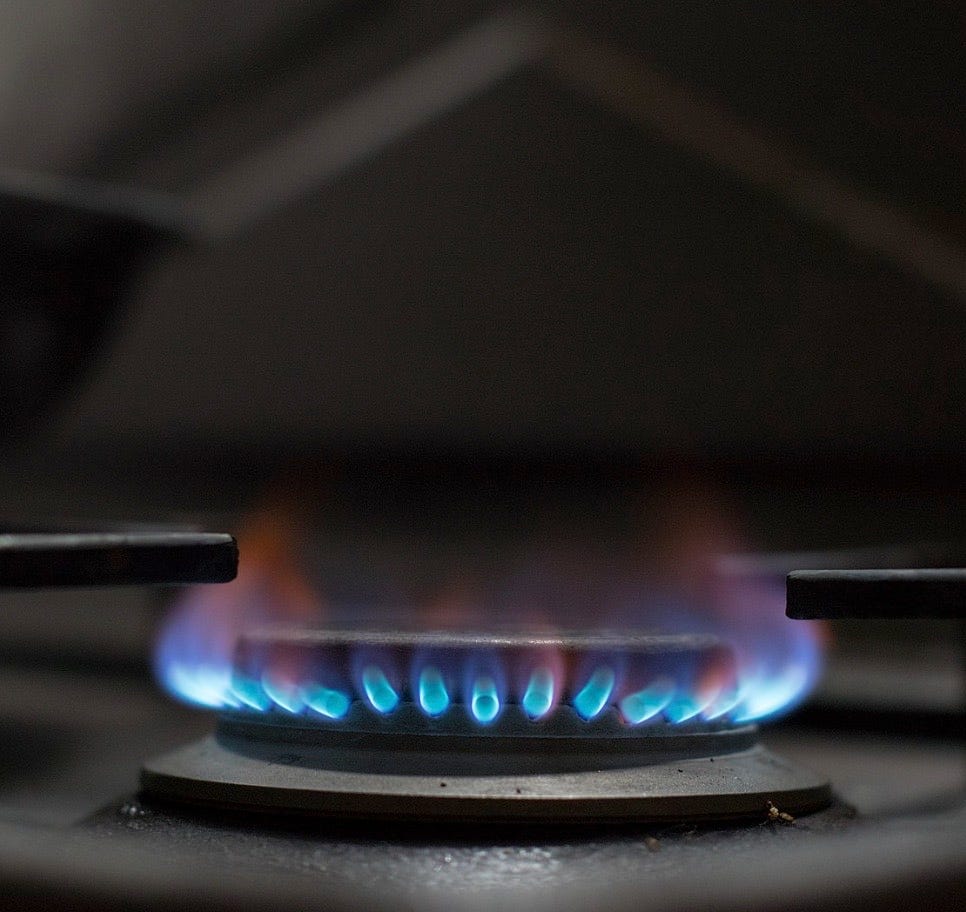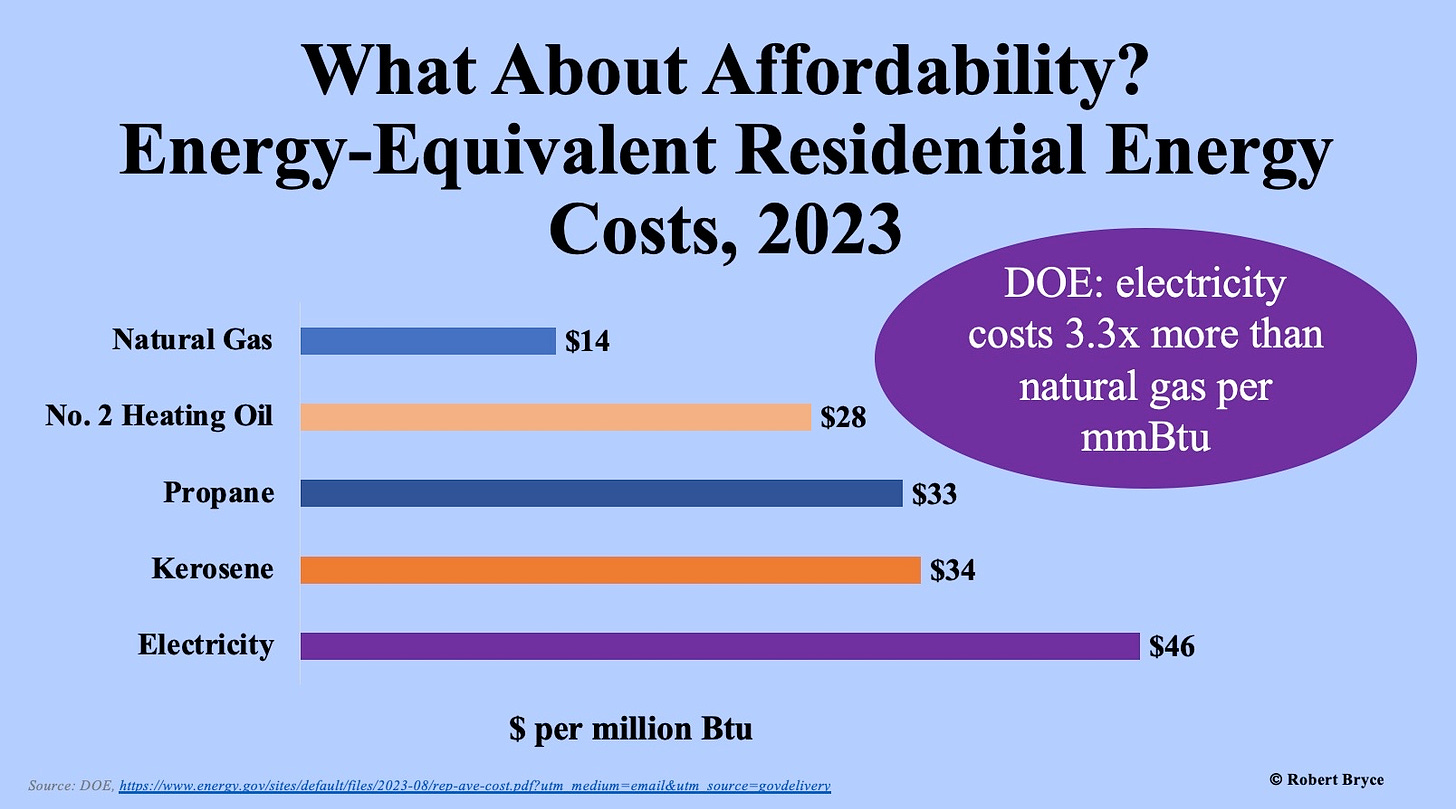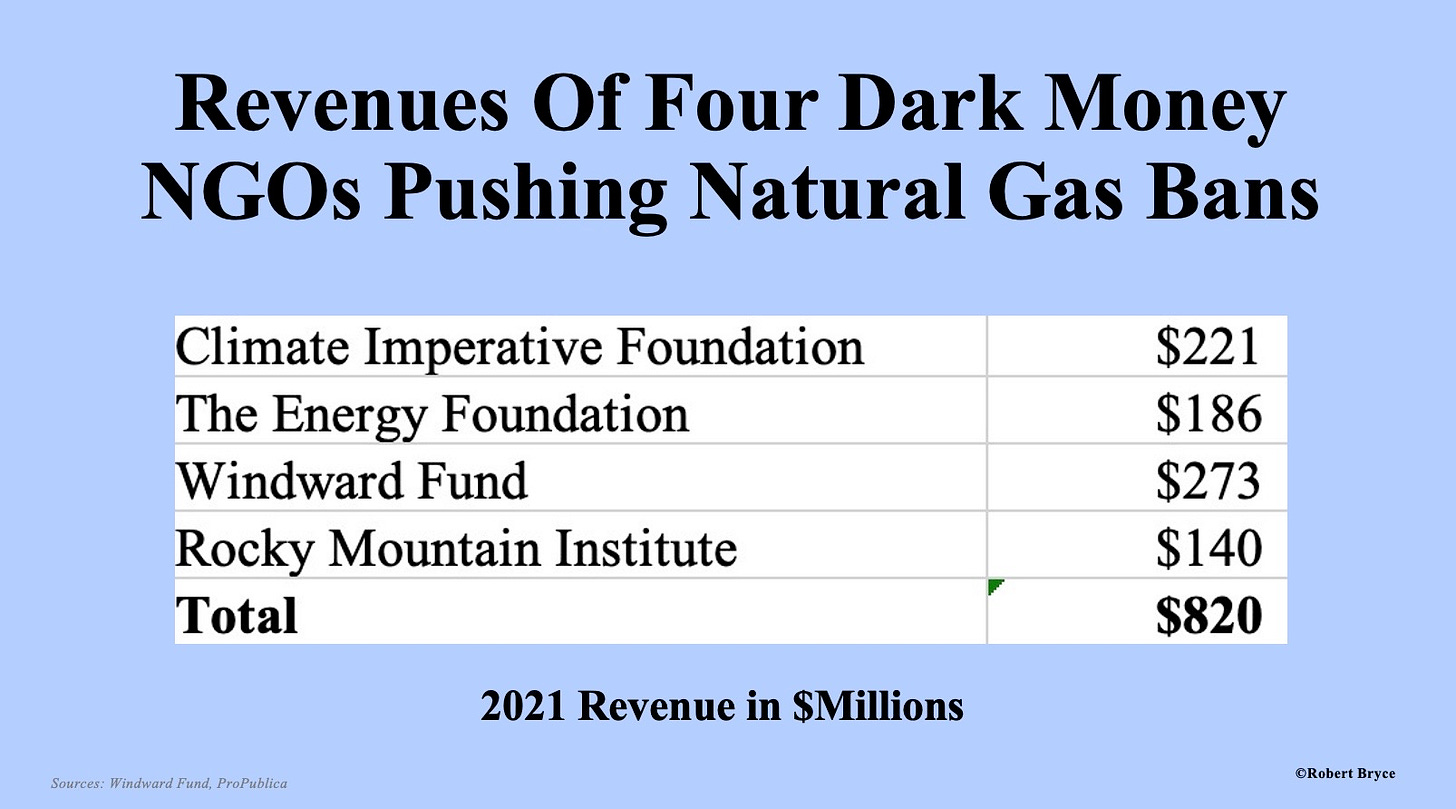More Proof That The Electrify Everything Push Is A Regressive Tax
Latest DOE numbers: electricity costs 3.3 times more than natural gas

On December 14, 2022, the Biden administration held “the first-ever White House Electrification Summit.” The goal of the meeting, which included officials from the White House Office of Science and Technology Policy, Climate Policy Office, and Office of Clean Energy Innovation and Implementation, along with leaders of various NGOs, including the American Federation of Teachers, Greenlining Institute, and Rewiring America, was to create a “strategy to accelerate affordable, equitable, and efficient electrification of American homes, businesses, and transportation.”
The same day of the Electrification Summit, the White House released a “rapid innovation agenda” that included President Biden’s goal of “a carbon pollution-free electricity grid by 2035, and to reach net-zero GHG emissions no later than 2050.” The same document claimed that by “electrifying our homes, businesses, industry, and transportation, the United States can get more than halfway to our goal of a net-zero emissions economy by 2050.” It also claimed, “Electrification will help enable the United States to reach net-zero emissions by 2050 while improving health, prosperity, and justice for all Americans.”
In April, the New York Times published an article headlined “How Electrifying Everything Became A Key Climate Solution.” The article, by Nadja Popovich and Brad Plumer, said that “To tackle climate change” the U.S. will have to quit burning fossil fuels in our engines, furnaces, and boilers, and the “best way to do that, experts increasingly say, is to replace them with electric versions.” The article quoted Saul Griffith, the founder and chief scientist at Rewiring America, a dark money group, that I wrote about here on Substack on March 19, in “The Dark Money Behind The Gas Bans.”
Griffith told the Times that “All roads point to electrification.” The Times did not mention that Rewiring America is leading the effort to ban the use of natural gas in homes and businesses. Nor did the Times bother to report that Rewiring America doesn’t disclose its budget or funders. The Times article didn’t contain the word “ratepayers,” and did not include “consumers.”
This lack of rigorous reporting by legacy media outlets is unfortunate. Alas, it’s not surprising. As with much of the rhetoric around alt-energy and decarbonization, cost figures — and the regressive effect that decarbonization mandates like bans on gas appliances will have on low- and middle-income consumers — are routinely ignored.
But last week, the Department of Energy published numbers that show, yet again, that the electrify everything push is, in reality, a regressive tax. The data, published by the Office of Energy Efficiency and Renewable Energy, forecasts the “representative average unit costs of five residential energy sources for the year 2023.”
Here's the punchline: On an energy-equivalent basis, electricity will cost 3.3 times more than natural gas this year. The forecast found that electricity will cost about $46 per million Btu while natural gas will cost about $14. The DOE numbers, which should have been published six months ago, gut the claims being made by NGOs, and in the White House press releases, that the electrify everything push will “lower energy costs.” The exact opposite is true.
To be clear, none of these findings are new. The representative average unit costs published annually by the DOE have consistently shown that using natural gas directly in the home is far cheaper than using electricity. I wrote about this regressive energy tax in Forbes back in 2021. The DOE’s 2019 numbers can be found here. The 2009 numbers are here.
What’s different now is that the electrify everything push is being pushed at the highest levels of the U.S. government and by lavishly funded dark money groups. As can be seen below, four of the groups pushing bans on natural gas have combined budgets totaling more than $800 million per year.
The electrify everything jihad isn’t just bad for the poor and the middle class. It’s also bad for the climate and energy security.
Burning gas directly allows consumers to use about 90% of the energy contained in the fuel. Using gas indirectly — by converting it into electricity and then using that juice to power a heat pump, stove, or water heater — wastes more than half of the energy in the fuel. That point was made by Glenn Ducat, in his excellent new book, Blue Oasis No More: Why We’re Not Going to “Beat” Global Warming and What We Need To Do About It. Ducat is a Ph.D. nuclear engineer who worked at Argonne National Lab, as well as at two electric utilities. As Ducat explains “Burning natural gas by residential commercial and industrial customers is at least twice as efficient and emits about half as much CO2 as processes that use electricity produced from fossil fuels. Converting process-heat applications to electricity before the electricity grid is completely carbon-free will increase CO2 emissions.”
Attempting to electrify everything will be disastrous for our energy security. One of the most famous quotes in the energy business comes from Winston Churchill, who famously said energy security comes from “variety and variety alone.” In other words, don’t put all your eggs in one energy basket. Yet, that’s exactly what the electrify everything crowd wants to do. And even worse, they want to do it at the very moment our electric grid is cracking under existing demand and key agencies are warning of reliability problems.
Just last week, the North American Electric Reliability Corporation released a report that identified energy policy as one of the biggest threats to the reliability of the grid. It was the first time it has called out policymakers as a threat. NERC said “The increase in natural gas and renewable variable energy generation and the simultaneous decline in nuclear, natural gas, oil, and coal-fired generation have implications” for resource adequacy on the grid. It continued, saying “mandates on decarbonization, decentralization, and electrification...will drive many rapid changes in the energy sector.” NERC said energy policy has become a risk factor because there is “no single jurisdiction that regulates or owns all policy directives or implications and state, federal, provincial — and private jurisdictions are to be respected.”
In other words, NERC is saying that the mishmash of local, state, and federal regulations is combining to create a situation where no one is in charge of reliability. The Federal Energy Regulatory Commission is also warning about reliability. On May 4, the acting chairman of the Federal Energy Regulatory Commission, Willie Phillips, told a Senate committee: “We face unprecedented challenges to the reliability of our nation’s electric system.” As I noted here on May 13 in “EPA v. The Grid,”
FERC Commissioner Mark Christie echoed Phillips’ warning, saying the U.S. electric grid is “heading for a very catastrophic situation in terms of reliability.” His colleague, Commissioner James Danly, averred that there is a “looming reliability crisis in our electricity markets.”
And yet, just a week after Danly and his fellow commissioners warned about the “looming reliability crisis,” the Environmental Protection Agency released a proposed greenhouse gas rule that could crush the reliability of our most important energy network. As reported by Politico, the new rule will require, “most fossil fuel power plants to slash their greenhouse gas pollution 90% between 2035 and 2040 — or shut down.”
Despite this looming crisis, NGOs like Rewiring America, Rocky Mountain Institute, and Sierra Club are pushing efforts that could dramatically increase the load on the electric grid. This is — excuse the technical term — crazytown.
The natural gas grid is part of our critical infrastructure. We shut it down at our extreme peril. The natural gas network is essential because it can deliver big surges of energy during periods of peak demand. In fact, on the coldest days of winter, the amount of energy delivered by the gas grid is roughly three times as great as the energy consumed during the hottest days of the summer.
During extremely cold weather, the gas grid delivers about 80 billion cubic feet per day to homes and businesses. In energy equivalent terms, that’s roughly 83 trillion Btu, or the energy output of about 1 terawatt of electric generation capacity for 24 hours. Put another way, to equal the 80 Bcf/d of gas delivered during cold snaps, the U.S. would need an electric grid nearly as large as the one we have now, which currently has about 1.3 terawatts of generation capacity.
Thanks to excellent geology, a century of gas production, and a fully developed transmission and distribution grid, the domestic natural gas sector can deliver surges of the fuel that are, in fact, lifesaving. That surge cannot be matched by the electric grid. That is due, in large part, to the fact that we can effectively store vast amounts of gas but only tiny quantities of electricity. In short, our electric grid cannot deliver the massive amounts of energy needed during the depths of winter. The most fundamental level of energy security is knowing that we won’t freeze to death due to a lack of energy during the winter.
So yes, the new DOE numbers show that natural gas continues to be the cheapest form of in-home energy. But the bigger, and more important thing to remember is that we need to keep, and maintain, our natural gas infrastructure. It’s not just critical for energy fairness, it’s critical to our energy security, and therefore, our national security.
But these realities continue to be ignored by policymakers. On July 31, Boston Mayor Michelle Wu signed an executive order banning the use of natural gas and other hydrocarbons in city-owned buildings. According to a city-issued press release, the measure “will take immediate effect.”
Click that ♡ button, please. And don’t forget to subscribe and share.
Thanks.




It certainly appears the trajectory for this process is a collapse of the energy infrastructure completely. I just hope the citizenry remembers who caused it all
As my frustration grows while reading an excellent article such as this, I keep reminding myself that at a White House briefing in November 2021, Energy Secretary Jennifer Granholm did not know how much oil the United States consumed daily. Maybe her excuse was why even bother when we’re looking to eliminate that source of energy. This entire subject is like watching a proverbial train wreck in super slow motion. Painful.